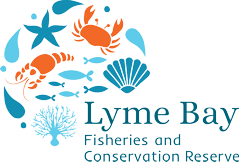Nature and wildlife
Lyme Regis sits within the Dorset Area of Outstanding Natural Beauty, it is a gateway to the Jurassic Coast, England’s only natural World Heritage Site, and is home to a National Nature Reserve and two Sites of Special Scientific Interest (SSSI) – this makes Lyme Regis a very unique and important landscape.
River Lim Path
The River Lim Path is a 1.5-mile (2.4km) walk along the river between Lyme Regis and Uplyme, although the path also forms part of both the East Devon Way and the Wessex Ridgeway.
The footpath was beautifully restored in 2018 as part of the Coastal Connections – People and Places bid to the Government’s Coastal Communities Fund. The Dorset Coastal Connections project comprised of 18 coordinated projects between Lyme Regis and Christchurch, which aimed to connect people to the coast, connect coastal communities to each other and connect the Dorset coast to the wider world.
The Lyme Regis to Uplyme access project enhanced the existing bridleway and public footpath connecting the Town Mill in Lyme Regis to Uplyme, running alongside the River Lim. Improvements included the restoration of the stone ramp leading to the ford near Jordan Flats, resurfacing of parts of the path, and new fencing along the river.
New seating and animal homes were installed using locally sourced materials, themed around the River Lim’s historical watermills. The wooden seating and innovative animal homes encourage people to stop at places along the path, perch on the benches, take in the natural views and wildlife and be inspired by the connections to the mill industry. The three seats can be found at Jericho, Windsor Terrace and The Glen in Uplyme. Take a stroll along the path and see for yourself!
A free pocket-sized map of the path, which highlights areas of historical interest and wildlife along the way, is available at the town council office or you can download a digital version of the map.
Find out more about the River Lim Path improvement project.
Slopes Farm
Slopes Farm is a 4.06-hectare wood in Lyme Regis, owned by the Woodland Trust. A public footpath crosses Slopes Farm, joining Woodmead Road and Roman Road, and it takes around 10 to 15 minutes to walk from one side to the other.
Slopes Farm was given to the Woodland Trust in 1988 and was previously part of grazed farmland around Slopes Farmhouse, which is now privately owned. The woodland was planted between 1989 and 2001. The main species planted were Oak, Ash, and Alder along with woody shrubs, and some mature trees in the existing hedges include Oak, Ash and a London Plane. The River Lim and a small stream on the boundaries add to the interest.
Slopes Farm sits on clay soil and is on the eastern edge of the Blackdowns National Character area, which is important, among other things, for geological interest and lowland mixed deciduous woodland.
Find out more about Slopes Farm on the Woodland Trust website.
Langmoor and Lister Gardens
The Langmoor and Lister Gardens were created as part of major stabilisation works completed in 2007. The gardens are a quiet and tranquil space, with plenty of winding paths to wander along, and grassed areas and benches to sit with a picnic and enjoy the spectacular views across Lyme Bay.
The planting is designed to encourage wildlife. Low shrubs have been planted for cover, with grasses and seed-bearing plants for invertebrates, butterflies and bees. Areas of the gardens are set aside for wildflower planting, creating havens for widlife and reintroducing native flowers into a manmade area. Two areas have specifically been dedicated as invertebrate gardens, featuring nectar-rich flowering plants, night-scented flowers and herbs. Butterflies, moths, bees and hoverflies need sources of nectar and pollen to thrive and as they travel from flower to flower, they also pollinate them, enabling them to set seed or bear fruit.
The Woodland Walk in the Langmoor and Lister Gardens provides a shaded pathway through the tall trees and the walk was enhanced several years ago with a new route through the woods. We have installed bird feeders, nest boxes, bird tables and bat boxes to encourage more wildlife to the area, and information boards highlighting the wildlife you may see.
In the Lister Gardens, an arboretum of 15 new specimen trees was established in 2022 to mark The Queen’s Platinum Jubilee. More than 70 new trees were planted across the town as part of the Queen’s Green Canopy, a UK-wide initiative focusing on sustainability and aiming to create a legacy to benefit future generations. As part of the scheme in the Lister Gardens, we removed non-native trees which were diseased, dying or leaning dangerously over properties and replaced them with species including maple, birch and the aptly named Acer Campestre Queen Elizabeth, a type of field maple.
A cherry tree avenue was also created near the Woodland Walk as part of the Queen’s Green Canopy, where 26 trees line the walkway. The beautiful cherry blossom provides early nectar and pollen for a range of insects in spring and the foliage is the main food plant for various moths and caterpillars.
Nature around town
On the outskirts of the town, the town council is creating wildlife corridors, which encourage wildlife into the urban environment and links Lyme Regis to other towns and villages. Managing these wildlife corridors involves the management of grassed areas, no mowing, introducing wildflowers, tree planting, hedge planting and avoiding the use of pesticides and herbicides.
The council also maintains wildflower areas around the town, including at the cemetery, on the banks behind the Marine Theatre, the bank outside Lyme Regis Football Club and at Monmouth Beach chalet and caravan park.
The Great Big Dorset Hedge

The Great Big Dorset Hedge is a campaign by Dorset Climate Action Network to map, plant, expand, extend and join up sections of hedgerow around and across Dorset into multiple corridors that promote biodiversity and help wildlife flourish.
Lyme Regis Town Council has provided financial support to the project to help improve hedgerow connectivity on the Ridgeway, one of the oldest public rights of way, extending from Lyme to join the Jubilee Trail, providing a key link in the Great Big Dorset Hedge and starting the focus at the coast. The project also involves surveying hedgerows linking footpaths from Lyme Regis into the surrounding countryside. Urban gardens are often very high in biodiversity and the hedgerows which run from gardens through semi-rural areas have a key role in linking across habitats between gardens and areas of woodland in farmed land.
Find out more about the Great Big Dorset Hedge.
Lyme Bay Fisheries and Conservation Reserve

Out to sea, Lyme Bay is a designated marine protected area, delivering benefits to marine life and the communities that depend on it. The project is a collaboration between fishermen, conservationists, scientists and regulators in Lyme Bay, ensuring the protection of important reef habitats and rare and threatened marine species, while also supporting sustainable and well-managed fishing and the communities that receive benefits from fishing responsibly.
To find out more about the project, visit the Lyme Bay Fisheries and Conservation Reserve website.